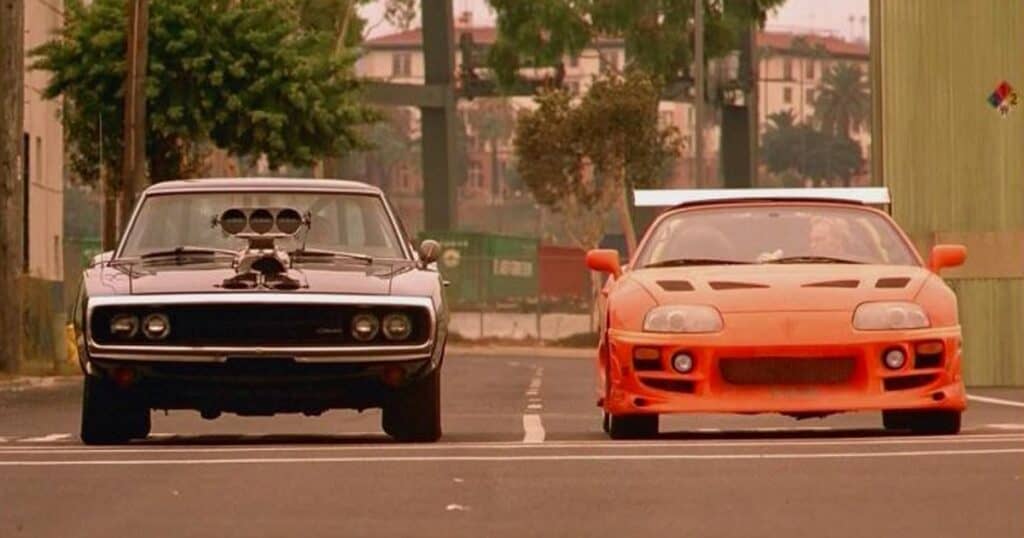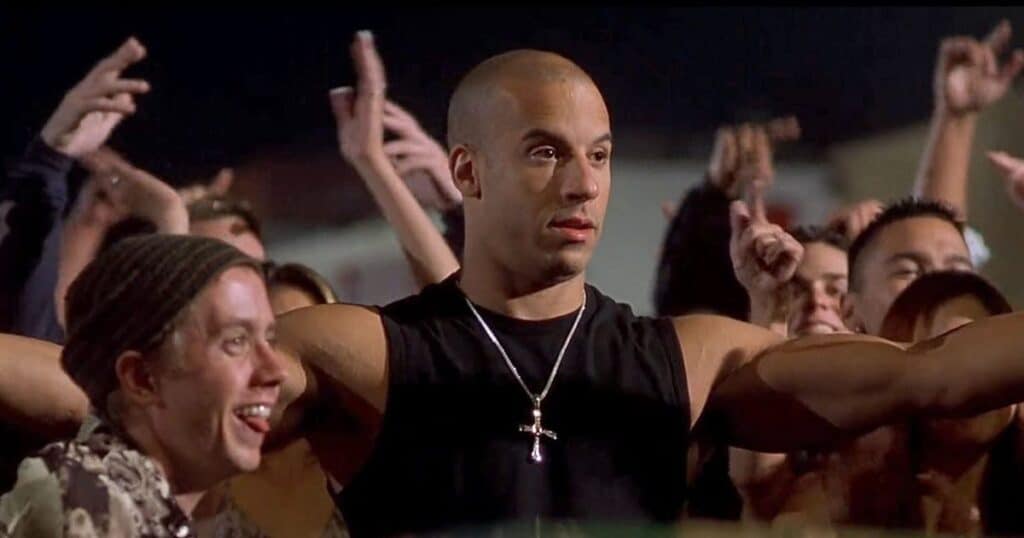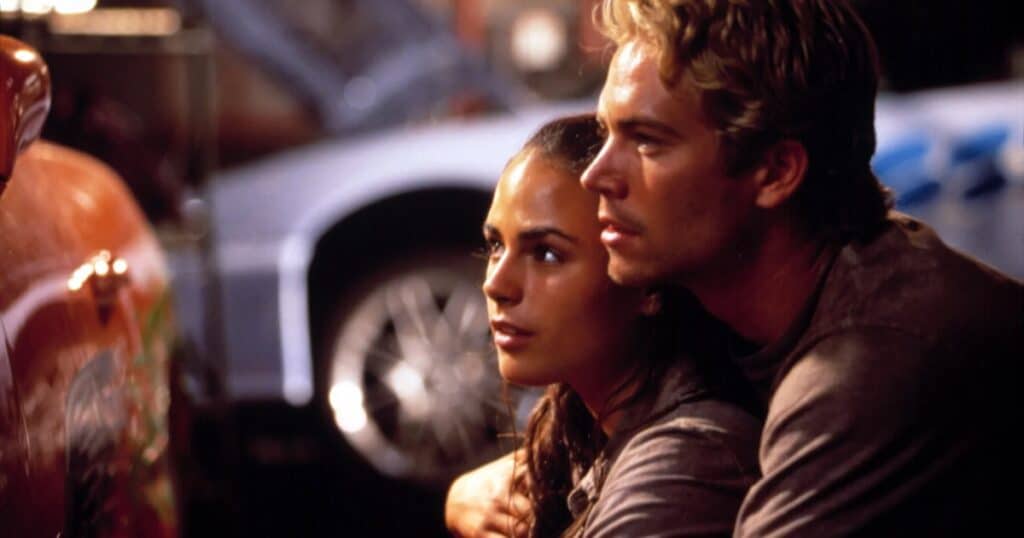This episode of Revisited was Written by Cody Hamman, Narrated by Travis Hopson, Edited by Juan Jimenez, Produced by Adam Walton and Chris Bumbray, and Executive Produced by Berge Garabedian.
INTRO: One of the biggest action franchises of the last twenty-five years had humble beginnings. It started with a simple little movie about street racing, based on a magazine article, with a cast of young people who weren’t very well-known and action scenes that are relatively grounded. That movie has somehow spawned multiple sequels and a spin-off. Along the way, those further installments have gotten bigger, crazier, and more over-the-top, while earning over six billion dollars at the worldwide box office. The movie we’re talking about is the 2001 release The Fast and the Furious (watch it HERE) – and it’s time for it to be Revisited.
SET-UP: The Fast and the Furious wouldn’t have happened if it weren’t for journalist Kenneth Li. That’s who wrote the article called Racer X for the May 1998 issue of Vibe magazine. Li’s two thousand word write-up looked into the urban street racing phenomenon that had made its way to New York after starting in Southern California. The racers Li met were catching the attention of police by shutting down the Henry Hudson Parkway near Manhattan to hold their illegal races. After run-ins with the law, some of them would take their races to legal racetracks, and they were looking forward to competing in Drag Wars, the Tri-State area’s first import street drag competition. This Vibe article caught the attention of executives at Universal Pictures. When they got in contact with Li about buying the film rights to the article, he thought it was a prank. But the offer was real: Racer X was going to become a movie.
Universal passed the article over to producer Neal H. Moritz, who was in the middle of working on The Skulls. A college-set thriller directed by Rob Cohen, starring Joshua Jackson and Paul Walker. The idea was that Moritz would produce this Racer X movie with Cohen directing. Moritz instantly saw the appeal of the concept, since he liked stories about subcultures. But Cohen didn’t see how the article could serve as the foundation for a movie. There wasn’t a story there, it was just about young people fixing up their cars and racing them. But then he went to a real illegal street race in California… and he started to understand how a movie could work. There would be racing, but inside an action-packed crime movie plot. Something along the lines of Point Break, but with cars instead of surfboards. Moritz and Cohen were already working with an actor who would be ideal for such a project: Paul Walker, who wanted to play an undercover cop in something, and to make a movie about racing cars. So even before a script had been written for the Racer X project, Walker signed on to star as the undercover cop who infiltrates a group of illegal street racers.
Now it was up to the screenwriters to get the story on the page in a satisfying way. The idea was to mix elements from Point Break and Donnie Brasco, which was about an FBI agent going undercover in the mafia. As well as thematic values from The Godfather: namely, a focus on family. As this franchise continued, the amount of times the word “family” is spoken in the films would become something of a running gag. Writers Gary Scott Thompson and Erik Bergquist were able to provide the basic set-up for what would become The Fast and the Furious. Then David Ayer was hired to do a rewrite, and he got the story closer to what we see in the finished film. That’s because Thompson and Bergquist’s drafts were still set in New York, like the magazine article. Ayer said he would only sign on if he could set it in Los Angeles, the original home of these street races, and make the characters more diverse. And that’s exactly what he did.
The project went through several different titles during development and production. Racer X, Race Wars, Street Wars. For a while, it was called Redline. The problem was, all of these titles seemed cheesy. Then Moritz watched a documentary on legendary producer Roger Corman. One of Corman’s early projects was a car chase film called The Fast and the Furious, released in 1954. And when that title came up in the documentary, Moritz realized it would be the perfect title for the movie he was making. So he pitched it to Universal and the studio was able to license the title from Corman. In exchange, Corman was able to use some stock footage that was owned by Universal.
The story Thompson, Bergquist, and Ayer crafted for this The Fast and the Furious centers on LAPD officer Brian O’Conner. The LAPD is working with the FBI to bring down a group of hijackers who have been pulling off highway robberies of trucks hauling loads of DVD players and digital cameras. There have been four robberies in the last two months, with over six million dollars worth of products stolen. The hijackers drive Honda Civics with Mashimoto ZX tires and green neon lighting. It’s clear that they’re from the street racing world. So Brian is to infiltrate that world, going undercover as a convicted car thief who now works at the auto shop where the racers get their parts. After a shaky start, Brian is able to befriend a group of racers headed up by Dominic Toretto. He’s able to earn Dom’s respect, and Dom can relate to his cover story because he has done some prison time as well. His father was a stock car driver who was killed in a race, and Dom attacked the driver responsible for the crash with a wrench. He went to jail for two years for nearly beating the guy to death. During his first night hanging out with Dom, Brian also meets a prime suspect in the hijacking case: Johnny Tran, a gang leader who is quick to send bullets flying if he feels someone has wronged him. Brian raids Tran’s home with the authorities… but his gang aren’t the hijackers. And then Brian realizes Dom is the leader of the hijackers, and the criminals are his new friends. Right at the start of Race Wars, a big drag race competition being held out in the desert, everything falls apart.
Universal told Cohen and Moritz that the movie would receive an instant greenlight for production if they cast Timothy Olyphant as Dom. But Olyphant had just been in a car movie the year before, Gone in 60 Seconds. He wasn’t interested in doing another one. The back-up choice Cohen and Moritz came up with was Vin Diesel, who was then best known for fighting aliens in Pitch Black and getting killed in Saving Private Ryan. When he said he wasn’t sold on the script, he was given the opportunity to sit down with David Ayer and go through it page by page. Together, they reworked Dominic Toretto, building him up and giving him a code of honor. Making him the type of guy who may be up to criminal business, but also regularly hosts a backyard barbecue for his friends that starts with someone saying grace. As Ayer told Entertainment Weekly, “I sat down with Vin and really created that character with him. Yeah, there were characters in the script but it needed life, it needed to become real, it needed to become dimensional. He had a few really specific ideas about the character, and those little touchstones he handed me became something I could flesh out. It’s an honor to help an actor create and achieve a vision.” And since Dom was said to own a Cuban bodega, Diesel went to Cuba to see what the real thing is like.

With Walker and Diesel locked in as Brian and Dom, the filmmakers built the supporting cast around them. Jordana Brewster, who didn’t have a driver’s license at the time, was cast as Dom’s sister Mia. Who becomes Brian’s love interest, much to the chagrin of Dom’s buddy Vince, played by Matt Schulze. Brewster had to get a license so she could drive in the movie, and so did Michelle Rodriguez, who was cast as Dom’s girlfriend Letty. In the script, Letty was just there to look good. The character had been described as a “trophy girlfriend”. Rodriguez demanded that she be given more depth and that her relationship with Dom be more layered. She also asked for a moment where she would get to punch somebody. Chad Lindberg was cast as the ill-fated Jesse, the computer and mechanics wizard of the group. And Johnny Strong was cast as Leon, the only surviving member of Dom’s team who hasn’t come back for any of the sequels. Strong has confessed that he hasn’t even watched the sequels.
Noel Gugliemi was cast as race organizer Hector. Ja Rule makes a cameo as a racer named Edwin. Ted Levine plays Sergeant Tanner, Brian’s supportive LAPD superior. Thom Barry is FBI Agent Bilkins, who’s in a hurry to catch the hijackers. And Rick Yune was cast as the villainous Johnny Tran.
Equipped with a budget of thirty-eight million dollars, The Fast and the Furious went into production in the summer of 2000. It was one of the least expensive movies Universal made that year. Maybe the cheapest of all. So the studio didn’t interfere with Cohen and Moritz while they were making the movie. And they made it on a tight schedule. Cohen said that nothing in the movie got the amount of time it should have had. They were always fighting the clock. But because the budget was low, they were allowed to do whatever they wanted. Even when they wanted to have neighborhood home owners repaint their houses in muted tones so the colorful race cars would look more vibrant on screen. And Universal was so pleased with the film they turned in, the decision was made to change the release date. The film was originally scheduled to reach theatres in March of 2001. They decided to push it back three months, making it one of their big summer releases.
REVIEW: The story of The Fast and the Furious works because they used the template of a movie that had already been successful ten years earlier. If you’re familiar with Point Break, watching this movie will have you feeling déjà vu at times. It covers a lot of the same ground. The undercover lawman infiltrating a group of fun-loving criminals. Romancing a woman who’s associated with that group. Not realizing his new pals are the people he’s looking for. Relating to the outlaws more than he relates to his fellow lawmen. Suspecting another group and conducting a fruitless raid on their base. Figuring out who he really needs to arrest just in time to find himself in the middle of a heist-gone-wrong. And, in the end, letting the mastermind walk away while other officers are closing in. The biggest difference here is that Keanu Reeves was letting Patrick Swayze surf off to his doom. Paul Walker lets Vin Diesel drive off to freedom… and a bunch of sequels.

So this was basically a Point Break remake long before we actually got a Point Break remake. But as the poor reception of the actual remake shows, just using a template isn’t everything. Many factors went into the success of The Fast and the Furious. The movie might not be accused of having a great script, but the script was exactly what it needed to be. The characters are fun and likeable, and each role was perfectly cast. That’s not to say that the acting is impeccable; some of the actors were just starting out and will admit that their performance wasn’t up to par. But there’s nothing too egregious on display. In some cases, as with Diesel and Rodriguez, the cast made the characters work better on film than they did on the page. And the actors had good chemistry with each other.
Walker and Diesel first bonded by attending a real, illegal street race together. When the race was broken up by the police, they ended up running down the side of the highway, hoping not to get caught. And so began a friendship that became more like a brotherhood. Walker reminded Diesel of his own twin brother, who also happens to be named Paul. They became a team that worked on several of these movies together. The pairing of Diesel and Rodriguez has also lasted throughout the franchise. Dom and Letty’s relationship was enhanced by the changes Rodriguez demanded, and it was expanded even further when Cohen saw how much chemistry the actors had with each other. Diesel has claimed that Dom and Letty have one of the greatest love stories in cinema history. And they’re not the only couple in this franchise that has an enduring love story. The connection Brian makes with Mia is a major part of the first film. Dom and Letty are already together when we meet them, but we see Brian and Mia falling for each other. We become invested in that relationship, which hits a major speed bump when Brian reveals he’s a cop. But that isn’t the end for Brian and Mia. They’ll be reunited a few sequels down the line.
This film also succeeded because it brought an interesting subculture to the screen. The young people who were already aware of these street races could see a version of themselves in the movie. And many of those who weren’t already aware of them were dazzled by the idea. The Fast and the Furious was nearly given a R rating due to injuries sustained by Vince in the disastrous final hijacking. Cohen made sure to cut back on the violence, as getting a PG-13 rating was very important. Teenagers had to be able to see this movie, especially those who weren’t old enough to get a license. Because, as the director said, who likes cars better than people who can’t drive them yet? There are plenty of cars to see. The Hondas, Toyotas, Nissans, Mitsubishis, Mazdas, Volkswagens, and Lexuses the racers drive. And the now iconic 1970 Dodge Charger that Dom keeps in his garage. His dad’s car.
The action sequences in the film are exciting even if you’re not into cars or the racing subculture. The hijackings and chase scenes are demonstrations of good, old fashioned stunt work. Cohen even drew inspiration from the 1939 John Wayne Western Stagecoach when plotting out the hijacking that opens the movie. These hijackings usually occur at night, with the criminals’ identities obscured by full-body dark clothing and helmets. The final robbery-gone-wrong takes place in broad daylight, and Dom and his crew are just wearing their regular clothes. This seems like a highly illogical decision on their part, but it was a choice that Cohen made for the benefit of the audience. The sequence happens during the day so the viewer can see everything that’s going on, and there’s no attempt to hide identities because we have to know what’s happening with each character.
For the race scenes, the director goes completely wild. These street races are only a quarter mile long and should be over in ten seconds. Which is why the characters are always talking about “ten second cars”. When Brian first competes in a race with Dom, the quarter mile race lasts for two minutes. The cars reach speeds as high as one hundred and fifty. The world outside their windows blurs like they’re hitting warp speed in a space ship and CGI takes us into the inner workings of the cars. It’s over-the-top and unrealistic, but it makes the race seem like something more than it would be if we just saw an actual ten second competition.

LEGACY / NOW: The Fast and the Furious was released on June 22nd, 2001 – and it connected with the audience the filmmakers had been hoping to reach. Point Break with cars turned out to be exactly what people wanted to watch that summer. The film opened at number one with forty million dollars and was on its way to earning over one hundred and forty-four million at the domestic box office. Internationally, it brought in almost sixty-two million more. Ending up with a total haul of more than two hundred and six million dollars. A great achievement for a movie that cost thirty-eight million.
Of course, Universal was instantly thinking sequel. And ironically, Diesel was against the idea, as he felt that a sequel would compromise the film’s chance of being considered a classic. So while the sequel gears started turning, he shifted his focus elsewhere. When The Fast and the Furious had started getting hype, Revolution Studios approached Diesel, Cohen, and Moritz with a project that would put a modern twist on the spy movie… by mixing in extreme sports. The month after The Fast and the Furious was released, it was announced that Diesel would be getting a ten million dollar payday to star in xXx, with Cohen directing and Moritz producing. But while Diesel and Cohen were busy getting up to spy business, Moritz still had time to produce the sequel to The Fast and the Furious that Diesel didn’t want.
Moritz has gone on to produce every film in the Fast and Furious franchise, guiding it from its scrappy street race movie origins to the globetrotting adventures these films became. Making billions for Universal in the process. One person who hasn’t seen a lot of money from the franchise is Kenneth Li, the journalist who wrote that Racer X article. Li was paid a six-figure lump sum for the film rights to his article. No percentage points, no residuals. And his friends make fun of him for making such a bad deal every time a new sequel is released.
Speaking with Entertainment Weekly, Diesel had this to say about not returning for the first sequel: “Sometimes you have to say no and stand for the integrity you hope to manifest in a film. Saying no in that moment of my life might have understandably been scary, and yet, it’s what allowed for everyone to commit wholeheartedly. Taking a pause is necessary when you want to really think about where you want to take something. (The franchise) totally started in a different place. It started very humble, and that’s something I’m grateful for, that we were able to start from humble beginnings so that you could really connect with these characters, without all the spectacle. The spectacle came as the movies needed to start one-upping themselves.”
But since Diesel skipped Part 2, the task of trying to one-up The Fast and the Furious fell on the shoulders of Paul Walker. He was the only cast member to return for the film that would come to be known as 2 Fast 2 Furious. And we’ll follow Walker’s character Brian O’Conner on his solo trip to Miami in the next episode of Revisited.
Originally published at https://www.joblo.com/the-fast-and-the-furious-2001-revisited/


